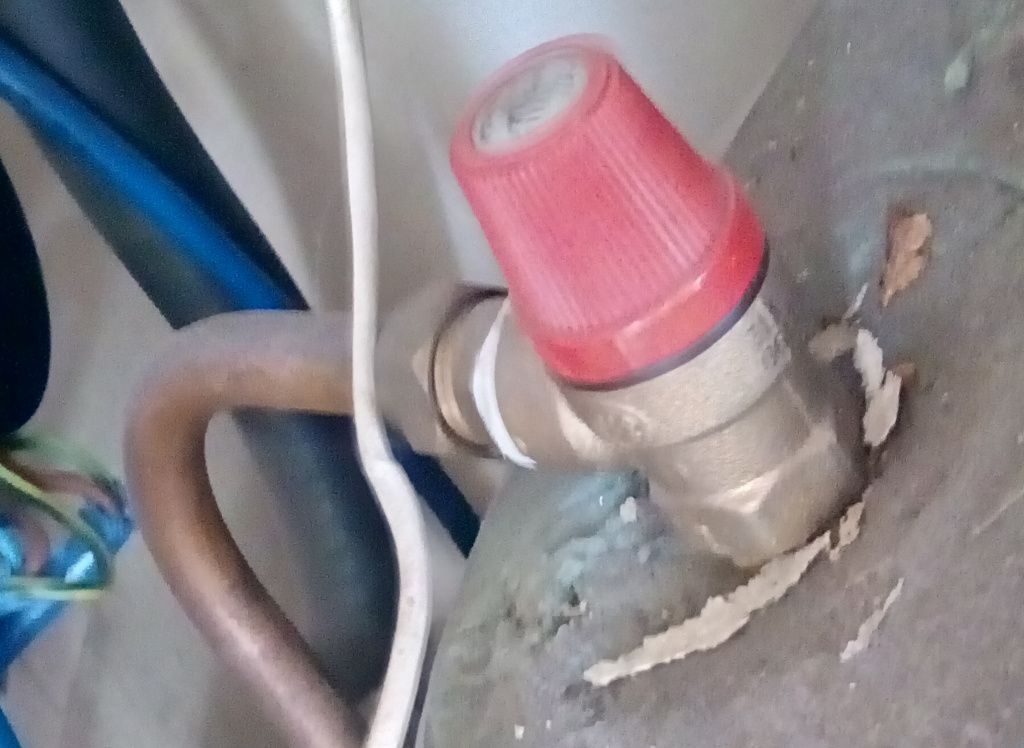-
Posts
7,784 -
Joined
-
Last visited
-
Days Won
50
Content Type
Profiles
Forums
Events
Gallery
Blogs
Store
Everything posted by Jen-in-Wellies
-

I hear water sloshing under shower I suspect!
Jen-in-Wellies replied to Lizette's topic in Boat Building & Maintenance
The most common type of PRV (pressure relief valve) looks like this - Its job is to release any excess pressure in the system. Very important. Sometimes they can drip because scale gets caught inside and prevents it closing properly. Follow the pipe that comes out of it and find out where the excess water ends up. Could go overboard, or in to the bilge, or in to a bottle that needs to be regularly emptied, or in to the engine bay. Depends. The copper pipe in my picture, but yours may be plastic. Turn the red knob a few times to try and clear the scale. Jen -
If it can float the same way up and is big enough to get on board, then it is a boat. After that, everything is optional.
-
Along the L&L in March? E's sure ta catch 'is death o' cold.
-
Welcome to the forum. Is this travelling on the Leeds & Liverpool Canal and the Bridgewater? Going there via the Mersey and the Manchester Ship Canal you can have a much bigger widebeam. By John Eyres - https://www.flickr.com/photos/32865578@N02/3418179672/, CC BY 2.0, https://commons.wikimedia.org/w/index.php?curid=16394014
-
This post cannot be displayed because it is in a forum which requires at least 10 posts to view.
-

Mitre gates versus single leaf - which is safer?
Jen-in-Wellies replied to magpie patrick's topic in General Boating
I see the problem. For mitre read single leaf, which is what I intended to say! Couldn't see it for looking. -

Mitre gates versus single leaf - which is safer?
Jen-in-Wellies replied to magpie patrick's topic in General Boating
Well, the first post says: So @magpie patrick was asking about bottom gates and that is what I replied to. I then went on to give my thoughts. I am fully aware that they single leaf gates are not commonly used on the bottom and are on the top, with some exceptions, like the Bosley flight that has mitres both ends. The reasons, I believe are more space required to swing the bottom gate past a boat in the lock and possibly less strength than a pair of mitres. Not sure how much more clear I needed to be? -

Mitre gates versus single leaf - which is safer?
Jen-in-Wellies replied to magpie patrick's topic in General Boating
The thread is about bottom gates. I'm talking about bottom gates. Read the first post. I've travelled by boat quite a lot thanks. -

Mitre gates versus single leaf - which is safer?
Jen-in-Wellies replied to magpie patrick's topic in General Boating
A single leaf gate in a decrepit state would be more at risk of blowing out I'd have thought. An arch is stronger than a beam and a pair of mitre gates is a sort of arch in construction. Other safety aspects would favour a single leaf. No risk of a bow, or rudder getting trapped in the mitre and the boat either hung up in falling water, or trapped down as the water rises. Also no risk of someone doing the bold step from a single closed mitre gate to the other and falling in. A lock would need to be designed with single leaf gates in mind as they need more space to swing for the same maximum length boat. Edited to add: I suspect it is rare to hear of a mitre narrow bottom lock gate blowing out because narrow mitre bottom lock gates are themselves rather rare! The few examples I can think of off the top of my head are on stop locks, so you only drop 6" or a foot in the resulting wooosh! Jen -
If the batteries are well charged and you aren't drawing power to run something, then that will limit the current from the panels. You need to compare a similar state of battery discharge, or better, compare the current in to a dummy load. Jen
-
You presume correctly. I assume this is a V belt. If so, are you sure you have the right width? Is the bottom of the groove in one, or more pulleys shiny? If it is, you may have too narrow a belt. V belts work by gripping the sloping sides of the pulley. Too narrow a belt and it runs on the bottom, where there is much less surface area to grip, hence they slip. V belts are available in several widths. If you try a wider one, then the length may need to be increased so it will fit. A friend had this problem with a raw water pump. Jen Unlikely to help. Below a certain speed, the alternator won't be able to start charging. Generally, people want to speed up boat alternators as they run slow compared with vehicle installations.
-
This post cannot be displayed because it is in a forum which requires at least 10 posts to view.
-
Often a question is asked to firm up what you were planning to do anyway. If we got rid of all of those the whole of CWDF could be backed up on a 3.5" floppy disk! I like the idea of outlining the rose in a contrasting colour and red seems a good one.
-
Which would barely show up on a very dark grey cabin. You could always tell people it is there, but they can't see it. Our the sign writer could tell you its been done and charge you, but you can't see it! I do like the style for the name.
-
Loads of stainless tanks around. Cracking is a very rare problem. Plastic tanks, either rigid, or flexible are available. A bilge pump in the bilge that a leak would go in to is a better solution. Bunding is generally used where you want to contain a nasty liquid, not potable water. Just pump it overboard. Most leaks happen in the plumbing, not the tank anyway. Tanks should be low down in the boat for stability. Ideally they should be balanced port to starboard, so the boat doesn't have weird lists as the tanks are filled and emptied. Multiple tanks don't need multiple pumps. The tanks can be interconnected so one pump draws from all. Valves can be used to switch the tank being pumped, or if all valves are open it becomes effectively one big tank. They can also be filled from a single point too. Care needs to be taken with air vents so they fill and empty properly, but can be done. Jen
-
<pedant>Since a scratch is where paint has been removed, all the polishing suggestions people have made are just removing more paint around it so all the paint is at the same level. They are answering the question - how do I make the scratch big enough so no one can see it any more? </pedant> ?
-
If you put logs on your solar panels, they won't generate any electric. ? If you are even asking the question, you know you're going to give in eventually and buy one! Bow to the inevitable...
-
Back in the 20 naughties, solar panels were very very expensive. I had a gadget, made in Slovakia, that turned the two 80W panels that I could afford to follow the sun through the day, then return to the start position overnight. If you were really keen, you adjusted the tilt angle between the seasons manually. Part way through the solar panel price crash of the previous decade, I bought a third 80W solar panel and mounted all three flat to the roof of the boat. Still get more out of them than two panels following the sun. No more dismantling the panels to cruise. No more worries about the wind catching them. Jen
-
Also, how tall are the people who will be steering the boat? Having to stand on tippy toes to see over the top, or peer round the sides would be a pain for any who are vertically challenged. I try and keep all roof mounted things as close to the roof as possible. Still had to remove stuff to fit through some canal infrastructure. Standedge tunnel particularly. Jen
-
4 panels wired series/parallel. If one has been completely smashed, then the other wired series with it will also not be connected. The other two will likely be unaffected, so you have two panels still. Even the broken panel may still be doing something, depending on how it is wired internally. There are series/parallel connections within the panel. The exact way will depend on the panel, but if there is still an intact series string between the red and black wires heading out, then it will still be producing something. The reduced capacity of this panel would likely drag the other one wired in series down to the same level, but again, the other pair of series wired panels would be unaffected. Before the panel is replaced, like with like, you can wire the remaining three in series, or parallel. If in series, make sure the max input voltage of your solar charge controller won't be exceeded. Use panel open circuit voltages for a safety margin. In parallel, make sure it won't exceed the max current for the charge controller. Not so much of a problem this time of year, with the sun still low in the sky. Jen
-
Not a wetvac. Lots of simple cheap hand pumps around. An example for £10, which I've not used, but can't be bothered finding the one I have on-line. Use some 8mm copper pipe so you are sure the intake side is at the bottom of the tank and pump in to a clear jar till you get diesel, not water. Jen Edited to add: Or this for £8. Lots of others.






